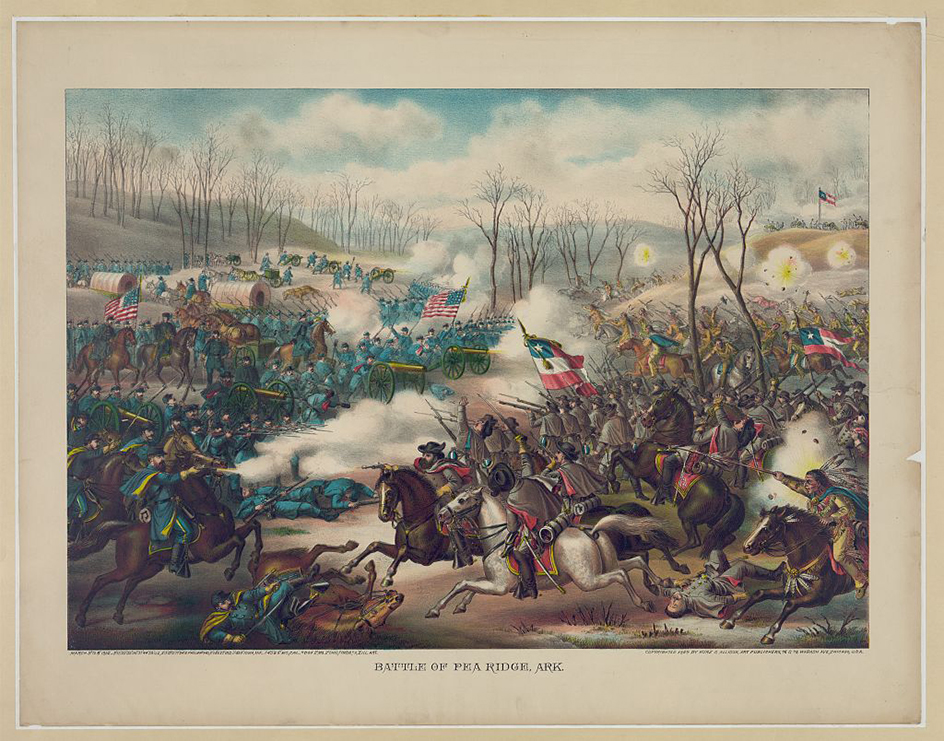Pea Ridge, Battle of, was an important battle of the American Civil War (1861-1865). The battle, named after a hill on the battlefield, took place in northwestern Arkansas, near the Missouri border, on March 7 and 8, 1862. It is also called the Battle of Elkhorn Tavern, after a building just east of Pea Ridge. Union forces led by General Samuel Curtis defeated a larger Confederate army under General Earl Van Dorn. The Union victory put Missouri solidly in Northern hands. The Battle of Pea Ridge was one of the largest battles fought west of the Mississippi River.

Background.
Missouri was a _border state—_that is, a slave state that lay between the North and the South. Missouri remained a part of the Union, but many of its residents supported the Confederacy. During the early part of the Civil War, Union and Confederate forces fought for control of the state. In August 1861, Confederate troops defeated Union forces at Wilson’s Creek, near Springfield. In February 1862, Union forces under General Curtis pushed the Confederate troops out of southwestern Missouri and into northwestern Arkansas.
On March 4, General Van Dorn and 16,500 Confederates set out to attack Curtis’s 10,500 troops in Missouri. Among Van Dorn’s troops were about 1,000 Cherokee Indians. Union scouts alerted Curtis to Van Dorn’s movements. Curtis ordered his troops, who had been scattered in southwestern Missouri and northwestern Arkansas, to gather near Pea Ridge. He had his men build entrenchments about 2 miles (3.2 kilometers) south of the ridge.
The Union entrenchments blocked the road on which Curtis expected the Confederates to arrive. However, Van Dorn did not want to attack an entrenched position. Van Dorn therefore divided his army into two forces and sent them to attack the rear of Curtis’s army. Van Dorn and General Sterling Price led forces that marched to the east side of Pea Ridge, near Elkhorn Tavern. The other Confederate force, commanded by General Ben McCulloch, marched toward Leetown. Leetown was a hamlet about halfway between Curtis’s defensive position and Pea Ridge.
Union scouts again alerted Curtis to Van Dorn’s movements. Curtis then turned his army around and divided them into two groups. He sent the troops to meet Van Dorn’s forces near Elkhorn Tavern and Leetown. Colonels Jefferson C. Davis and Peter Osterhaus led the Union divisions near Leetown.
The battle.
On the morning of March 7, 1862, Van Dorn’s troops attacked Curtis’s soldiers near Elkhorn Tavern. The Union troops were able to withstand the first two Confederate charges. They were later pushed back until Union reinforcements stopped the Confederate advance.

Near Leetown, McCulloch’s Confederates attacked the Union position. They were initially successful. However, Union soldiers killed McCulloch and the Confederate second-in-command, Brigadier General James McIntosh. They also captured the next highest ranking officer. The leaderless Confederates became disorganized, and many Confederates left the battlefield. The remaining soldiers marched east, around Pea Ridge, to join Van Dorn and Price near Elkorn Tavern. Upon learning that the threat near Leetown had ended, Curtis shifted his remaining troops toward Elkhorn Tavern.
Curtis correctly suspected that the Confederates were low on ammunition. On March 8, he launched a new attack. An opening artillery duel silenced the Confederate cannons. The Union army then routed the Confederates and scattered them from the battlefield.
The aftermath.
Over the course of the Battle of Pea Ridge, each side suffered about 1,300 casualties (soldiers killed, wounded, or captured). Missouri remained securely in Union hands for two more years. In the fall of 1864, Price tried to capture Missouri for the Confederacy in a daring raid. Curtis defeated him once again. Price’s defeat marked the end of full-scale fighting in the state.
See also Civil War, American ; Wilson’s Creek, Battle of .
